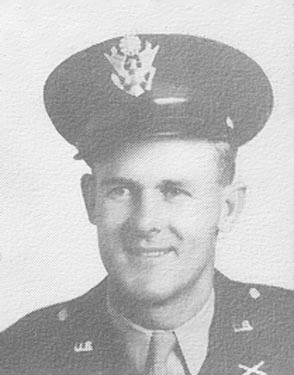 |
jacklummus.com Home Page Search Contact Us Site Map
Click the <Back> arrow to return to the previous page.
Biography of Walter Johnson Windham
 |
Italy, Texas
Walter
Windham was a first lieutenant in the United States Army. He had joined the
Texas National Guard in 1940, but on August 28 President Franklin Delano
Roosevelt signed a congressional bill that authorized him to call 360,000
members of the National Guard and Army Reserve for twelve months of active duty.
In November the federal government mobilized the Texas National Guard, and on
November 25 the Thirty-sixth Infantry Division, which included Walter Windham,
reported to Camp Bowie near Brownwood in Brown County, Texas. Camp Bowie had
been established in September of 1940, and initially designated the training
center for the infantry and artillery of the 36th.
While
serving with the 36th at Camp Bowie, Walter Johnson Windham and Mary Edith
Whitson were united in marriage on Saturday, February 1, 1941 at 8:00 p.m. at
the home of Rev. McDaniel, a Methodist minister in Milford, Texas. After a brief
honeymoon Edith returned to Dallas on Sunday night, where she was employed, and Walter to Camp
Bowie, where he was stationed.
On
January 14, 1942 the Army announced that a tank destroyer tactical and firing
center would be established near Killeen, Texas. On September 18 Camp Hood,
named for Confederate General John Bell Hood, was officially opened. Walter
Windham was transferred to Camp Hood, and attended Officers Training School, and
on October 30, he was commissioned a second lieutenant.
On
June 15, 1942 the 76th Infantry Division was reactivated, and would serve as a
training division for most of 1942 and 1943. The Army first activated the 76th
in August of 1917 for World War I, and the Division became known as the
“Onaway Division.” “Onaway” is the alert cry of the Chippewa Indians,
and was adopted by the 76th following the completion of their training on
Chippewa hunting grounds.
Lieutenant
Windham joined the 808th Tank Destroyer Battalion, probably at Camp Hood, which
was attached to the 76th Infantry Division. In 1943 he was appointed first
lieutenant, and along with his unit engaged in intensive training prior to
receiving orders for overseas deployment. In December the 76th with attached
units were embarked aboard transports at New York, and sailed for England
arriving on December 21, 1944, and probably arrived at Gosport, which is a port
in southern England on the English Channel. It served as a port of embarkation
for Allied troops for the invasion of northern France in 1944. The first command
post for the 76th was set up in Bournemouth, which is a coastal city to the west
of Gosport. The area surrounding Bournemouth may have served as a training area
for the 76th. Both, Gosport and Bournemouth, are in Hampshire County.
On
January 12, 1945 the 76th embarked, probably at Gosport, for a channel crossing
southeast to the debarkation port and supply base at Le Havre in northwestern
France at the mouth of the Seine River. At Le Havre, the 76th was assigned to
the Third Army, commanded by General George Smith Patton. The 76th proceeded
eastward overland to Limesy in the Seine-Inferieure Region of France, and to
Beine, east of Reims, in the Marne Region before turning northeast to reach the
Champlon area in the Luxembourg Region of Belgium on January 23, where it
prepared for combat.
The
76th proceeded southeast to the vicinity of Echternach, Luxembourg at the common
border between Luxembourg and Germany. It relieved the 87th Division on January
25 at their defensive positions along the Sauer and Moselle Rivers. The 76th
sent out patrols, and crossed the Sauer breaching the Siegfried Line in a heavy
assault on February 7. The advance continued across the Prum and Nims Rivers,
and by February 24 turned south to join Patton’s Twentieth Corps near Trier,
which is located in southwestern Germany on the Moselle River.
First
Lieutenant Windham was commander of a M36 Tank Destroyer with a crew of five.
The M36 was the most powerful American antitank weapon of World War II. It
weighed in at thirty-one tons with a 90 mm (3.54 inch) high-velocity
antiaircraft/antitank gun that fired armor piercing rounds. These awesome
machines were being utilized against the numerous pillboxes of the Siegfried
Line, and to support the infantry against artillery and armor. But, they were
not indestructible. On February 27, 1945, in a valley about one mile north of
Meckel, Germany, Lt. Windham was killed in action when three concealed German 88
mm (3.46 inch) guns correctly plotted his range. He was buried in Luxembourg. He
was 30.
First
Lieutenant Walter Johnson Windham was the son of Mr. William Hardy Windham and Mrs. Kate
Irene (Hogan) Windham of Italy. He was born on February 25, 1915 and reared in
Italy in Ellis County, Texas. He graduated Italy High School, and attended
Trinity University in Waxahachie. He was the spouse of Mary Edith (Whitson)
Windham and the father of one-year old William Harlan Windham.
Following
World War II, Lieutenant Windham was reburied in Italy Cemetery.
He was posthumously awarded the Bronze Star and Purple Heart Medals. He is listed on the Italy Town Marker and Ellis County Veterans Memorial.
The bio information is courtesy of Bill Windham, Tyler, Texas.
Click the <Back> arrow to return to the previous page.
© 1999-2003 Utility Press Inc. All rights reserved.